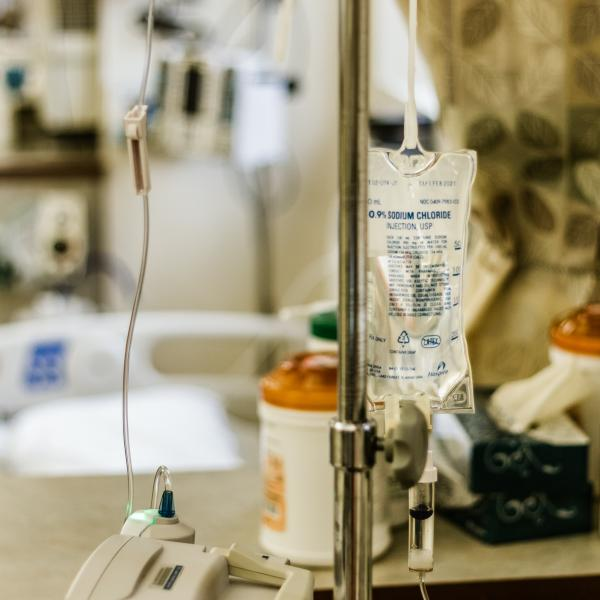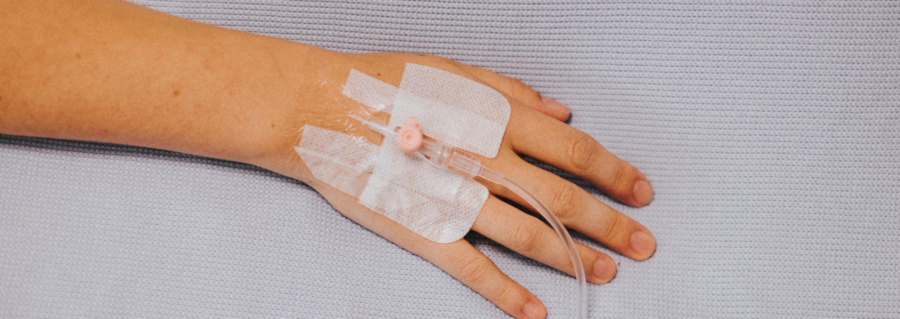
Chemotherapy is the use of drugs to destroy cancer cells (cytotoxic). Chemotherapy works to prevent the lymphoma cells from multiplying and to remove or reduce the number of cancerous cells in the body. It is often part of a larger plan, used in combination with other therapies.
Michael Cooney, Nurse Practitioner
How does Chemotherapy work?
Normal body cells divide in an orderly way and they split into 2 identical new cells. Normal cells are tightly controlled by our immune system (lymphocytes). When they are not needed anymore, have lived their normal lifespan or are damaged, the lymphocytes will work together to destroy and remove these normal cells from your body.
When the cells become cancerous, the cells keep dividing uncontrollably, until there is a mass of cells. Chemotherapy kills cells that are dividing. The faster the cells multiply, the more sensitive they can be to chemotherapy.
Why is chemotherapy used to treat lymphoma?
Chemotherapy circulates throughout the body in the bloodstream and lymphatic system. Chemotherapy can treat cancer cells almost anywhere in the body. Therefore, chemotherapy or other systemic treatments (travel through the bloodstream) can work well for the treatment of lymphoma (also known as systemic cancer).
In the centre of each living cell is a nucleus. The nucleus is the control centre for the cell. It contains chromosomes which are made up of genes. Chemotherapy damages the genes inside of the nucleus.
Chemotherapy regimen
There are many ways of attacking rapidly dividing cells and hence there are many different types of chemotherapy. Each chemotherapy medicine attacks the cell in a specific way but because these are all different ways of achieving the same result, which is destruction of the cancer cells.
Chemotherapy is often given in combination with other medicines to attack the lymphoma cells from all possible angles (affecting cells during different points in the cell dividing process). This increases the odds of achieving remission (cancer free).
A course of chemotherapy usually involves several treatments. Each treatment is called a ‘cycle’ of chemotherapy. A cycle can usually be over a 1-4-week period. The doctor may recommend 2-8 cycles of chemotherapy. The break between chemotherapy doses, is generally the minimum amount of time for healthy cells, such as immune system cells, to recover before receiving the next dose of chemotherapy. This is to prevent the cancer cells from recovering and giving the patient the chance to remain well during the treatment. For example, chemotherapy is given on day one of the cycle and then there is a rest for 3 weeks. After the break and the patient has ‘recovered’ the next cycle will begin. A rest period follows each cycle of chemotherapy. The doctor will decide how many cycles will be needed for each patient.
How is chemotherapy given?
Most chemotherapy treatments are given in a day oncology centre, so patients can go home on the day of their treatment. Some patients can be admitted into the hospital for their treatment and this could be for a few days as an inpatient. It can be given;
- Orally (by mouth)
- Intravenously (into a vein)
- Intrathecally (into the cerebrospinal fluid usually via a lumbar puncture)
- Subcutaneously (in the fat layer under the skin)
Oral chemotherapy (by mouth)
Oral chemotherapy is taken by mouth. It can be in the form of a tablet, capsule, or liquid. This form of chemotherapy can be taken at home and will most likely not require a hospital stay.
A nurse or pharmacist in the day chemotherapy unit will give directions on how to safely take medications at home. Patients will be given extremely specific information on the dose, side effects, health monitoring and information on how to safely handle and manage chemotherapy at home.
Oral chemotherapy does not come without side effects, so it is important that patients let their medical team know if there are any concerns or a dose is missed. Examples of oral chemotherapy are chlorambucil or cyclophosphamide.
Intravenous chemotherapy
Intravenous chemotherapy is given into a vein. Intravenous chemotherapy can either be given through a cannula, or a central venous access device (CVAD).

A cannula is a small soft plastic tube that is inserted into a vein in your hand or arm. The cannula is usually inserted by a doctor or nurse. Prior to inserting the cannula, the area is cleaned and prepared. The needle is then put into the skin. The needle is removed, and a small soft plastic tube is left in place. It is securely taped in place for the duration of the treatment. The cannula is usually taken out on the day after the treatment is completed.
A central venous access device is a thin plastic tube that remains in your vein throughout the course of treatment. It is not removed after each cycle. Examples of central venous access devices are:
- Central line (in neck or chest)
- Hickman line (in the chest)
- Peripherally inserted central catheter (in the arm)
- Port-a-catheter (small device inserted under the skin of the chest or arm)
This plastic tube is a lot bigger than the plastic tube in a cannula, and it is put into a bigger vein. Central venous access devices are put in under local or general anaesthetic. These devices can be left in for months or for the duration of the whole treatment. Patients will be given strict directions about how to care for their device and will also be given strict instructions on the signs and symptoms of infection in the device.
Once the cannula is inserted or the central venous access device is accessed, premedications and chemotherapy are then administered by the nurses in the day oncology unit. Premedications can be given as a push or through a pump. Chemotherapy drugs are usually mixed in the pharmacy and delivered to the oncology day unit. They are then administered as bolus or through an intravenous pump. All medications are administered differently. Some medications may take a few minutes to administer while others may take a few hours. The health care team will be able to explain all of this to you prior to the treatment.
Examples of intravenous chemotherapy are doxorubicin, cyclophosphamide, and vincristine.
Intrathecal chemotherapy
Intrathecal chemotherapy is given into the fluid that surrounds the brain and spinal cord. This is called the cerebrospinal fluid (CSF). The brain and spinal cord are surrounded by a highly selective semipermeable border of endothelial cells called the blood-brain barrier. The blood-brain barrier prevents solutes in the circulating blood from crossing into the extracellular fluid of the central nervous system where the neurons reside. The blood-brain barrier prevents many drugs from getting into the central nervous system. Intrathecal chemotherapy is the way of bypassing the blood-brain barrier. The drug is given directly into the central nervous system. Intrathecal chemotherapy is administered as an injection into your spine, in the lower back. It is like a lumbar puncture.
Examples of intrathecal chemotherapy are methotrexate and cytarabine.
Subcutaneous chemotherapy
Subcutaneous therapy is given to the fat layer that lies just below the skin. The nurse injects the drug through a tiny needle into the skin on your stomach, upper arm, or thigh.
Example of subcutaneous chemotherapy is cytarabine.
Common side effects of treatment
There are many different side effects of the treatment, that is individual for each regimen. The treating doctor and/or cancer nurse will explain these to the patient before the start of treatment. For further information on some of the most common side effects and ways to help self-manage these see the section ‘common side-effects of treatment’.
Some of the more common side effects of treatment for lymphoma may include:
- Anaemia (low red blood cells carry oxygen around the body)
- Thrombocytopenia (low platelets that help bleeding and clotting)
- Neutropenia (low white blood cells help with immunity)
- Nausea and vomiting
- Bowel problems such as constipation or diarrhoea
- Fatigue (tiredness or lack of energy)
- Reduced fertility
The medical team, doctor, cancer nurse or pharmacist, should provide information about the treatment, the common side effects, what symptoms to report and who to contact.
Fertility preservation
Some treatments for lymphoma can reduce fertility and this is more likely with certain chemotherapy protocols (combinations of drugs) and high-dose chemotherapy used before a stem cell transplant. Radiotherapy to the pelvis also increases the likelihood of reduced fertility. Some antibody therapies may also affect fertility, but this is less clear.
The doctor should advise whether fertility may be affected or whether fertility preservation should be done before the start of treatment. Speak to the doctor and/or specialist cancer nurse prior to the start of treatment about whether fertility will be affected.
Precautions after chemotherapy
Patients should take precautions after chemotherapy:
- Take precautions with body fluids during each chemotherapy treatment and for 48 hours afterwards.
- Some medicines may need to take precautions for a longer time.
Ask the doctor or nurse about these precautions and for how long to take these precautions.
Precautions at home
Precautions reduce the chance of family members or carers coming into contact with chemotherapy medicines. Ask the doctor or nurse about which precautions to use with each treatment.
Going to the toilet:
- Sit on the toilet seat to use the toilet
- After using the toilet, close the lid and flush the toilet.
- Wash hands with soap and water.
Managing body fluids
Precautions need to be taken with body fluids:
- Disposing of used incontinence pads or nappies
- Managing vomit by using a plastic bowl or plastic bags
- Cleaning up spills or body fluids that includes vomit, urine, blood, sperm, or faeces
- Soiled clothing or bedding (wash separately)
- Contact on skin (wash area with soap and water)
- Use disposable gloves and paper towels (tie into plastic bag to dispose)
- Wash hands with soap and water
Sex and protection:
- You and your partner should use effective birth control to prevent pregnancy during your treatment. This is because chemotherapy medicines can harm an unborn baby.
- You should use a condom or other physical barrier if you have any type of sex after each treatment. This is to reduce exposure of your partner to these medicines in semen or vaginal fluids. This usually applies for 48 hours but may be up to 7 days for certain drugs.
Other common questions:
Can I hug and touch my family?
Yes, it is safe to touch other people, and to hug and cuddle your family.
Can other people use the same toilet as me?
Yes, others can use the same toilet. If body fluids splash on the toilet seat, wear disposable gloves and wipe down the area with soapy water before other people use the toilet.
LWL Chemotherapy
Donna Gairns

